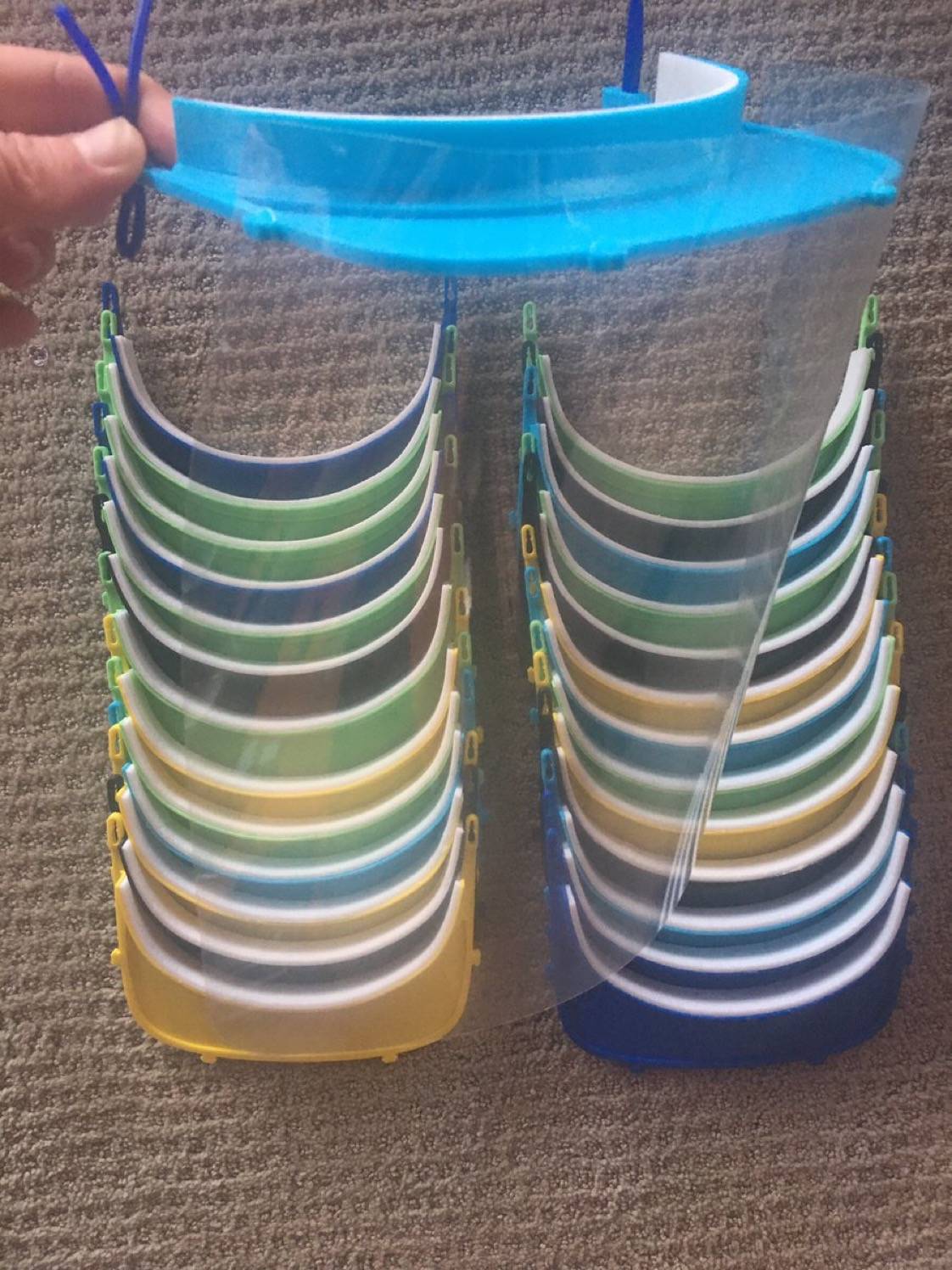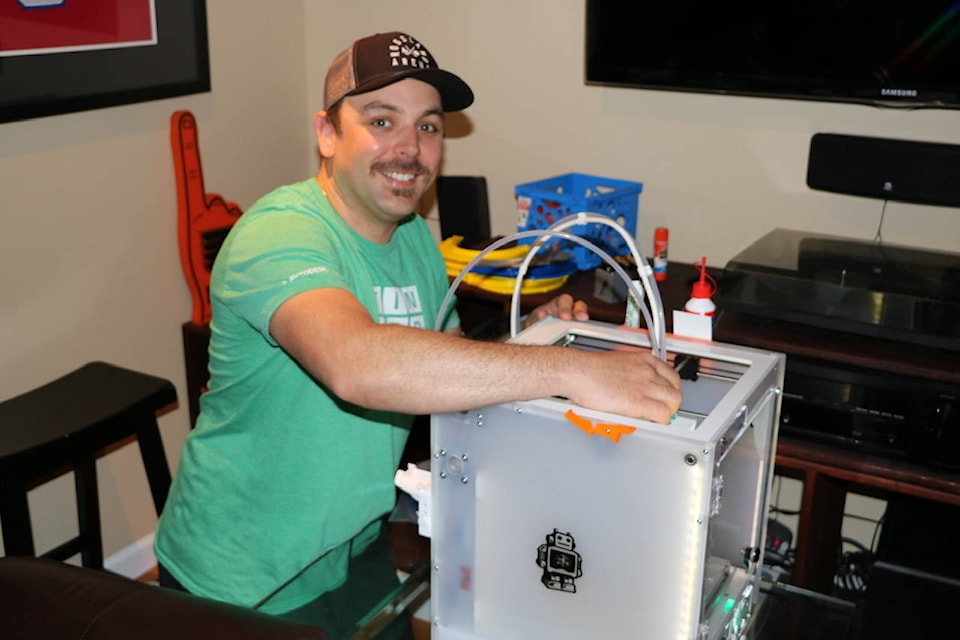What started as a brainstorming idea between a West Kootenay doctor and an engineer has become a PPE-making force of nature in the Kootenays.
Last month, Engineer Lee Wasilenko of Nelson partnered with General Practitioner Dr. Michael Vance to create personal protection devices (PPE) on 3D printers. The Kootenay Makers for COVID-19 recruited Trail businesses like Austin Innovations, MIDAS Labs, and Hall Printing as well as local churches and volunteers, who immediately and generously pitched in.
Related read: Kootenay doctor mobilizes engineers in effort to bolster PPE supply
The result has been nothing short of amazing. In a matter of days their GoFundMe page had exceeded its goal, and by Apr. 1 the team had over 1,000 masks ready to ship to frontline workers at Kootenay Boundary Regional Hospital (KBRH) and Kootenay Lake Hospital (KLH).
“We’ve definitely had a huge response from the community between Nelson, Trail, and Castlegar,” said Wasilenko. “So, a lot of people who have come forward with 3D printers, laser cutters, that kind of thing; they are willing to help out in any way they can, so that’s been really great.”
PPE shortages have adversely affected healthcare workers all over the world, so for Dr. Vance and Wasilenko anticipating the same problem was a major factor in helping the West Kootenay prepare for COVID-19.
“Jason Taylor (MIDAS) and Mary Austin have come up in a big way and they’ve really scaled up production using large format laser cutters so we’ve been able to meet the initial demand from the hospitals and clinics pretty quickly.”
A FaceBook group organized by Shane Hainsworth and Leticia Nugent, Kootenay Makers for Covid-19 PPE Production, has been coordinating the effort to make, drop off, and deliver PPE to meet local demand. A number of private and public innovators came online and are now creating PPE at home in their basements and at their businesses.
“We have a FaceBook group set up for this, to keep everyone on the same page. And I think thats one of the biggest things about the project, it’s been a big morale booster for the hospitals, just to know that the community is there for them.”
Mike Page, vice-principal at Twin Rivers Elementary for School District 20 (SD20), joined the group and brought in fellow teachers Fred Nock, Nate Lott, and Danny Leeming.
Through SD20, Page and Lott had met and worked with Taylor at MIDAS for the past few years, and became familiar with 3D printing and its potential.
“That is where we started learning all our knowledge around 3D printing, and not just 3D printing but anything like coding and things like that,” said Page. “Jason is such a good wealth of knowledge and is very helpful.”
The group also enlisted a laser cutter from J. L. Crowe. The teachers had the tools, but sourcing materials was another matter, until they found a simple solution - just ask.
“The community support has been amazing,” said Page. “The amount of Amazon boxes of materials that just keeps showing up at my house is just fantastic - just from a simple FaceBook post. I just put my address on there and people were asking and sending me money to buy other supplements, like filaments, so it’s been awesome.”
With the support of School Districts 8 and 20, the teachers began using the design created by MIDAS and Austin Innovations and were soon pumping out PPE as fast as their 3D-printers could go. Which is not super fast, however, collectively the teachers’ 10 printers have the capacity to work around the clock and produce hundreds of PPE for frontline workers every day.
West Kootenay and other BC and Alberta businesses donated plastic filament and clear mylar sheets so they soon had enough to make about 500 masks.
Page switched over to making ear-protectors, and made about 1,000 in one week. He also enlisted the help of his family to keep the process going when he is at work.
“I’ll go to about 11 or 12 at night, and then maybe about 5:30 a.m. I’ll fire another one on,” said Page. “So there is a night time period when they are not going. But I’ve been having to go to work so my sister (Andrea) and wife (Bailey), they know how to run the printer now because they’re doing it seven or eight times a day on three printers in my basement.”
The PPE are going to doctors, nurses, paramedics, medical clinics, care homes, firefighters, first responders, and other frontline workers. The group recently received a request for 200 more visors, so Page switched back over and says the group will continue as long as there is a need.
Meanwhile, the response from the frontline workers has been overwhelmingly positive for the PPE produced locally.
“The advantage of the ones we’ve designed is that they are sanitizeable and reusable,” said Wasilenko. “You can take them apart and clean every component and use them again without having to throw out the whole thing.
“Obviously some of this stuff doesn’t go through the jurisdictional channels that it normally does, but when it comes to life or death, and getting them the equipment they need, then we can do it. So I think that’s been really good for morale. And the quality of the product, Mike (Dr. Vance) has gotten feedback from the staff who are saying, these are the best face shields they’ve had.”
In addition to the reusable face sheilds, the production line has diversified. The Kootenay Makers are printing ear-savers, Rossland’s MoFab contributed MDF visors, and Kootenay Glass and Mirror created aerosol boxes for intubation procedures at KBRH, KLH, and the Cranbrook hospitals.
The Kootenay Makers’ efforts to fight COVID-19 will continue, but also evolve once the market catches up to the unprecedented demand.
“This project was always only meant to be a stop-gap until the free-market could come up with a solution, which we see is happening now,” said Wasilenko. “We’ve kind of met the initial demand. We’ve gotten what they need now, now there will be free-market solutions coming from all over Canada as factors for retooling to make PPE to fight COVID catch up.”
The Nelson engineer sends a sincere thank you to all the contributors to the project, the GoFundMe page donors, and most of all the frontline workers. The reserve funds will go to reimburse individuals and businesses for expenses and maintenance of machines, and act as an emergency reserve. At the end of the project, any funds remaining will be donated to the respective hospital foundations.
sports@trailtimes.ca
Like us on Facebook and follow us on Twitter

